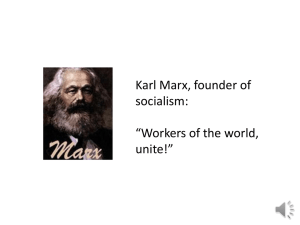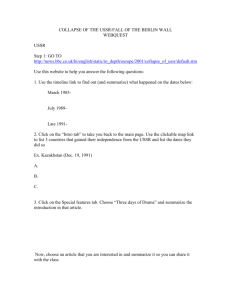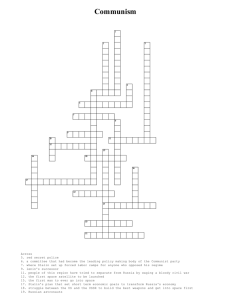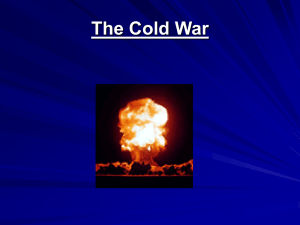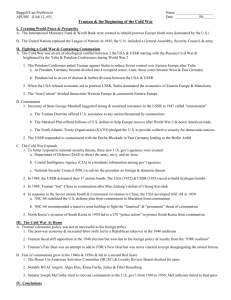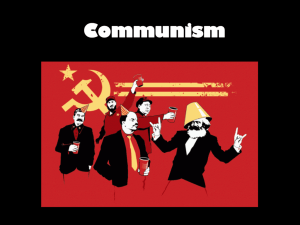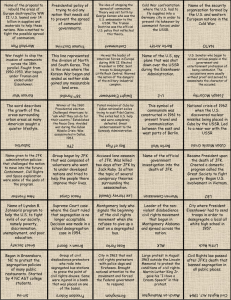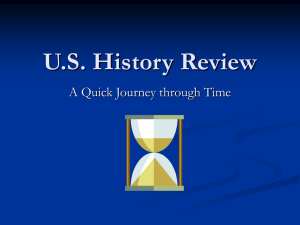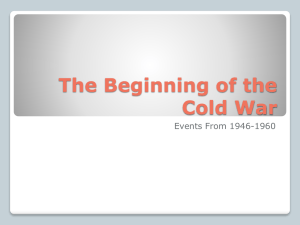Year 11 GCSE History Revision – USA
advertisement
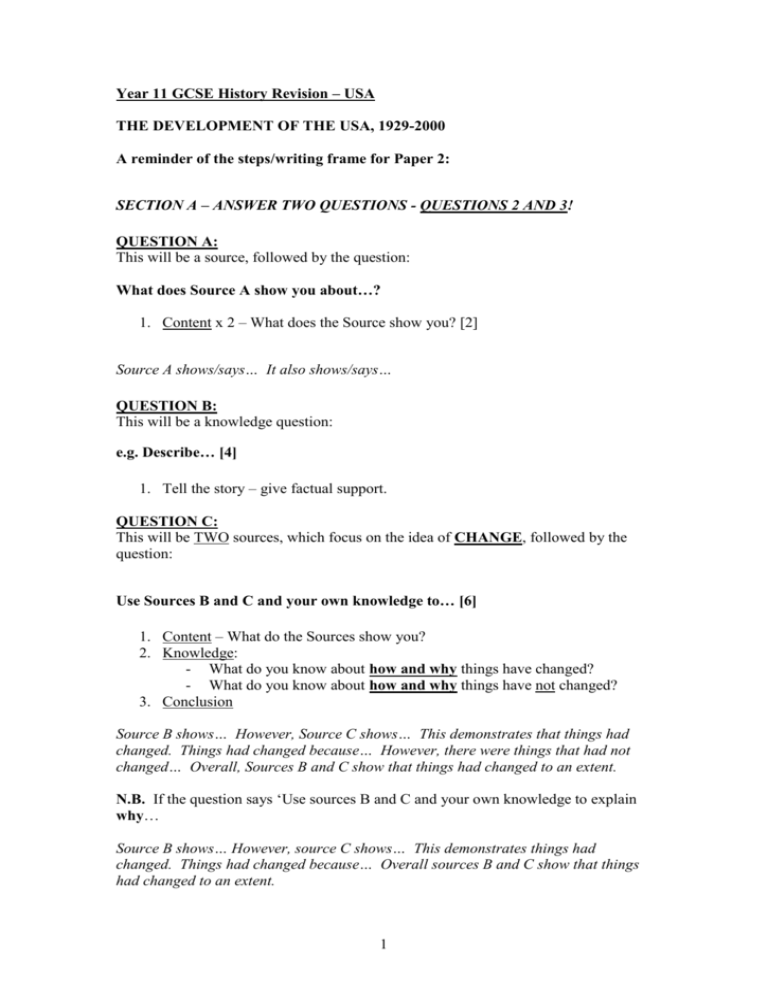
Year 11 GCSE History Revision – USA THE DEVELOPMENT OF THE USA, 1929-2000 A reminder of the steps/writing frame for Paper 2: SECTION A – ANSWER TWO QUESTIONS - QUESTIONS 2 AND 3! QUESTION A: This will be a source, followed by the question: What does Source A show you about…? 1. Content x 2 – What does the Source show you? [2] Source A shows/says… It also shows/says… QUESTION B: This will be a knowledge question: e.g. Describe… [4] 1. Tell the story – give factual support. QUESTION C: This will be TWO sources, which focus on the idea of CHANGE, followed by the question: Use Sources B and C and your own knowledge to… [6] 1. Content – What do the Sources show you? 2. Knowledge: - What do you know about how and why things have changed? - What do you know about how and why things have not changed? 3. Conclusion Source B shows… However, Source C shows… This demonstrates that things had changed. Things had changed because… However, there were things that had not changed… Overall, Sources B and C show that things had changed to an extent. N.B. If the question says ‘Use sources B and C and your own knowledge to explain why… Source B shows… However, source C shows… This demonstrates things had changed. Things had changed because… Overall sources B and C show that things had changed to an extent. 1 QUESTION D: This will be a knowledge question: There are several possibilities of how this question will be asked: How important/Why was X a turning point/What was the significance of…/Why was X important/etc. [8] 1. Give reasons – back up with fact and explanation. 2. Conclusion. … was important because… For example… This demonstrates… SECTION B – ANSWER ONE QUESTION YOU WILL BE ABLE TO CHOOSE FROM QUESTION 5 OR 6 BUT QUESTION 5 (THE RACE ISSUE) IS THE BEST ONE TO DO! QUESTION 5 – THE RACE ISSUE This will be a knowledge question: e.g. What have been the most important factors in bringing about change in the lives of black Americans since 1929? [10] IT DOES NOT MATTER WHAT THE QUESTION IS, THE ANSWER IS ALWAYS THE SAME!!! 1. Underline the key word/s in the question – this is the phrase you need to use in your answer. 2. Write out your pre-learned answer, using the words from the question i.e. everything in order. 2 The Race Issue, 1929-2000 – Summary 1. Segregation and the Jim Crow Laws Segregation is the separation of black and white people in the Southern States of the USA. e.g. separate schools, seating on buses. The Jim Crow Laws legalised segregation as long as facilities were separate but equal. The Jim Crow laws also stopped black people from voting. This was done by: The Poll Tax – black people were too poor to pay so not registered to vote. Literacy test – made too hard for black people to pass. Intimidation – black people were afraid to vote. Black people had lowest standards of education and therefore poorest paid jobs (menial) In the 1920s many black people moved North in search of a better life – factories gave better pay but they lived in ghettos. 2. The KKK To keep white supremacy. Members were WASPS. Active in southern states. Attacked blacks, Jews, Catholics, etc. Wore white robes and hoods, carried blazing cross. Raped, tarred and feathered, beat, whipped and lynched victims. Got away with crimes as police and judges were members, also juries were scared to convict. Membership was 5 million by 1924, but fell after 1925. 3. The NAACP The National Association for the Advancement of Coloured People. Aimed to end segregation and lynching, and get black people the right to vote. 1920s – fought against lynching and encouraged black people to vote. 1930s, 40s and 50s – took cases to court to fight discrimination e.g Topeka, Rosa Parks etc. Led to black middle class e.g. owned own businesses, money etc. 4. UNIA Led by Marcus Garvey Slogans ‘Back to Africa’ and ‘Black is beautiful’ Aim to make black Americans proud of their culture etc. 3 5. The Depression Hit in 1929. Black people affected the worst – last to be hired, first to be fired; blamed so lynching rose; white people took black menial jobs. If kept jobs wages lowered. Dust storms made it worse in southern states as agriculture destroyed. New Deal helped 1 million blacks e.g. work camps and relief. However, blacks last in line for New Deal due to white racism and work camps segregated. 6. The Second World War US army was segregated – Jim Crow Army. Selective Service Act 1940 stopped discrimination in calling up and training (1 million joined). Blacks in Britain saw life without segregation – more determined for change. 2 million black workers worked in war factories in north. Membership of NAACP went from 50,000 to 450,000. Double V campaign for rights at end of war. After war, Fair Deal 1946 ended segregation in army. 7. Education Changes Brown v. Topeka – 1954, Linda Brown’s father (Oliver) took board of education to court as she had to walk 20 blacks to school when there was a white school 2 blocks away. NAACP helped. Supreme Court ordered end of segregation in schools. But by end of 1956, not one black child attending an integrated school. Little Rock – 1957, 9 black pupils, led by Elizabeth Eckford, tried to enter Little Rock High. Governor placed National Guard around to block their way. Angry white mob gathered. President Eisenhower sent 1000 federal troops to protect black pupils for rest of school year. By 1960 only 2600 black children out of 2 million attended integrated schools. James Meredith – 1962, Governor of Mississippi stopped him entering university. President Kennedy sent troops to protect Meredith. 8. Boycotts and Freedom Rides Rosa Parks, 1956 – refused to give up seat on a bus to a white man. Started Montgomery bus boycott. Helped by NAACP (she was a secretary for them) and MLK. Boycott worked – end of segregation on buses. However, segregation on interstate transport and waiting rooms remained. Freedom Rides, 1961 – organised by CORE. Attorney General Robert Kennedy had to send in 500 marshals to protect the Freedom Riders. By 1963 4 segregation illegal in all bus and rail stations and airports, and most other public facilities. 9. Martin Luther King Non-violent/peaceful protest – e.g. freedom marches, sit-ins, boycotts, freedom rides. Freedom marchers in Birmingham, Alabama, 1962 attacked by water cannons, dogs and baton charges authorised by Eugene ‘Bull’ Connor. Gained white sympathy and Kennedy ended segregation in Birmingham. ‘I Have a Dream’ speech, August 1963 attended by 250,000 people, including 50,000 white people at Lincoln Memorial, Washington D.C. Won the Nobel Peace Prize. Leader of the bus boycott. Helped gain the Voting Rights Act 1965. Assassinated in 1968. 10. Black Power 1950s increased membership of Nation of Islam, led by Elijah Muhammed. They wanted a race war, a separate state for black people and replaced ‘Christian slave surnames’ with the letter X. Grew into the Black Power movement. Black Panthers was one of the most militant groups, led by Malcolm X. Popular in northern states where no real progress had been made. Caused riots in 1960s in Harlem and New York, and Watts in LA. 11. Civil Rights Legislation President Eisenhower passed Civil Rights Acts of 1957 and 1960 – made discrimination illegal and gave the right to vote.(But ignored) Kennedy’s programme was put into place by Johnson. Led to the Civil Rights Act 1964 – banned racial discrimination in employment, black pupils were given equal rights to enter all public places and the Equal Employment Opportunities Commission was set up to investigate complaints of discrimination. 1965 – Voting Rights Act. 1967 – state laws banning interracial marriage were declared illegal. 1968 – Fair Housing Act made discrimination illegal in the property market. 12. Economic Progress Up to 1990 1970s – backlash against bussing children long distances to school. Still discrimination in housing market. No equal standards in education. Black cultural movement in 1970s – ‘black is beautiful’. 5 1980s – films of Spike Lee and novels of Toni Morrison celebrated black culture. 1967 Carl Stokes first black mayor of a major city. Reverend Jesse Jackson stood for 1984 Presidential Election. 1989 – Colin Powell became Chairman of the Joint Chiefs of Staff. Black celebrities like Will Smith and Eddie Murphy became famous. 1990 the average income of a black family less than half a white family. 13. Progress Up to 2000 1990 Barack Obama elected editor of the Harvard Law Review. Average income still less than whites. 30 % of black people live below the poverty line compared with 9 % of whites. 6 The Wider World – Summary 1. Isolationism The USA’s policy of the 1920s and 1930s, to cut themselves off from world affairs, to avoid a war. They did not join the League of Nations or WWII when it broke out in 1939. Introduced the Neutrality Acts – 1935 banned ships carrying weapons to countries at war; 1936 banned loans to countries at war; 1937 Cash and Carry meant US could sell weapons to countries at war as long as they paid cash and picked them up themselves. However, they took the lead in disarmament meetings, invested in Europe to help them recover after WWI and signed the Kellog-Briand Pact. Therefore they were not truly isolated. Isolated because of memory of WWI, public opinion favoured isolation, the US saw themselves as geographically isolated from Europe, they wanted to concentrate on getting themselves out of depression. 2. The Rising Threat of Japan Japan had become industrialised and overpopulated so needed raw materials. Japan wanted to get raw materials from Asia instead and was prepared to use force. Japan invaded Manchuria, part of China in 1931. The League of Nations told Japan to withdraw from China. They did not force them. This was because the USA and USSR were not members of the League of Nations so it did not have much power. USA stopped sale of oil to Japan as punishment (had bought 80% from the USA). 3. World War Two War broke out in Europe in 1939. The USA did not join. Japan launched a surprise attack on the USA’s fleet at Pearl Harbor on Sunday 7th December 1941. 8 battleships were sunk, 188 planes destroyed; and 2403 people were killed. The USA declared war on Japan. Germany declared war on the USA. The USA was now involved in World War Two. The USA fought Germany in North Africa, Italy and then took part in the DDay landings in Normandy, France, which eventually led to Germany’s surrender on 8th May 1945. D-day on 6th June 1944 landed 130,000 troops on Utah and Omaha, helped by Mulberry Harbours and Pluto. 7 The USA fought Japan in the Pacific. Carrier War – aircraft launched from ships. Japan used kamikaze pilots, USA island hopped. USA won Midway Island and Coral Sea, and destroyed Japanese navy at Leyte Gulf. USA took control of Iwo Jima and Okinawa. The Japanese would not surrender so the USA dropped two Atomic Bombs on Hiroshima and Nagasaki. The Japanese surrendered on 15th August 1945. 4. The Truman Doctrine and Marshall Aid After WWII the USA and USSR entered the Cold War – a war that stopped short of actual fighting as they both had nuclear weapons so did not want to risk a war. The argument was over communism – the USSR was communist and the USA did not like communism. The USA was afraid of the domino effect – the fear that countries would fall to communism one by one like dominoes. The USA thus followed the policy of containment – stopping the spread of communism. This was announced by the Truman Doctrine – President Truman’s promise in 1947 to help countries threatened by ‘internal or external forces’ (communism). Marshal Aid was the money that put the Truman Doctrine into practice - $13 billion in aid to countries in Europe affected by WWII. Stalin (leader of USSR) refused to let countries in Eastern Europe accept it. The USA responded by keeping its military forces close to wartime levels, building up its nuclear weapons, setting up the NSC and the CIA. 5. Cold War 1 - The Importance of Berlin Berlin had been divided into 4 following the end of WWII. Britain, the USA and France put capitalism into their zones, and joined them together as Bizonia. The USSR put communism into their zone and exploited it to rebuild the USSR. Stalin saw Bizonia as a threat so launched the ‘Berlin Blockade’ in 1948 – closed off all road, rail and canal links between the West and West Berlin. The USA could not use force so launched the ‘Berlin Airlift’ where they flew in supplies to West Berlin. This was necessary or the people there would have starved. Stalin could not shoot the planes down as it would be an act of war so he removed the blockade in May 1949. The USA joined NATO in September 1949 and the USSR tested its first nuclear bomb. Berlin was important again in the 1960s. Khrushchev built the Berlin Wall in August 1961, partly in revenge and partly to stop refugees leaving East Germany for West Germany. 8 6. The Korean War Korea was divided along the 38th parallel – North was Communist; South was capitalist. In June 1950 the North invaded the South, backed up by the USSR. President Truman sent troops to help the South, backed up by the UN (led by General Macarthur). The USA pushed the North back over the 38th parallel. However, they got too close to China (who was also communist) so China joined in. The war ended in a stalemate in 1953, with the border running almost along the 38th parallel. 100,000 troops had been wounded, 54,000 killed. The USA had stopped the domino effect, at least. 7. The Cuban Missile Crisis In 1959 Castro became leader of Cuba. The USA thought he might be communist so Kennedy tried to get rid of him with the Bay of Pigs invasion by Cuban exiles in 1961. The Bay of Pigs was a disaster, and Castro sought help from the USSR. The USSR placed missiles on Cuba. These could hit all major US cities, so the USA was very worried. Kennedy blockaded Cuba to force the Russians to negotiate. Khrushchev sent two letters to Kennedy – the first promised to remove the missiles from Cuba as long as the USA removed the blockade and promised not to invade Cuba. The second added that the USA should remove their missiles from Turkey. Kennedy agreed to the first letter in public; the second in private. It looked like the USA had got the USSR to back down. Both leaders were accused of brinkmanship (bringing the world to the brink of a nuclear war); a telephone hotline was installed between the Whitehouse and the Kremlin and a Test-Ban Treaty was signed in 1963 outlawing testing of nuclear weapons. 8. Vietnam North was communist; South was capitalist. Ho Chi Minh, leader of the North invaded the South to try to make it communist also. (National Liberation Front – NLF) Eisenhower and Kennedy had both sent weapons and 16,000 advisers but no troops. Johnson sent troops. Eisenhower, Kennedy and Johnson all intervened because of the domino effect, the policy of containment and to put the Truman Doctrine into practice. 9 Johnson sent troops because by 1963 the North had control of 40% of the South; he also thought war would help the USA’s economy and the Gulf of Tonkin (where US ships were attacked by the North) gave him an excuse. The US tactics included ‘Operation Rolling Thunder’ (a massive bombing campaign of the north), the use of Napalm and Agent Orange, and ‘search and destroy’. The Vietcong (North) used guerrilla warfare – tunnels, using the jungle to hide, merging with civilians, as well as big attacks like the Tet Offensive. People back in the US opposed the war due to the tactics (My Lai massacre was televised in 1969) and famous people like MLK, Muhammed Ali and Jane Fonda speaking out. Nixon decided to pull out of Vietnam, but equip the south to fight for themselves – Vietnamisation. By 1976 Vietnam had turned communist completely. Cambodia and Laos followed. The domino effect had happened and containment had failed. 9. Détente 1 Détente means a relaxation in tensions during the Cold War. Both the USA and USSR wanted better relations to reduce the risk of nuclear war, to reduce the cost of the arms race, and because the Vietnam War had shown the USA they should change policy. Détente with China – Nixon visited China in his ‘journey for peace’ in 1972; let China take its seat in the UN in 1971; and the US table tennis team played matches in Peking (Ping-Pong diplomacy). Nixon was ‘holding his nose’ and working with China even though he didn’t like them. Détente with the USSR – Nixon visited Moscow in 1971; SALT I was agreed in 1972 (limited the number of missiles); the Helsinki Accords were signed in 1975 (recognised that the USSR had control of Eastern Europe); SALT II talks were held but never signed. 10. Cold War 2 The USSR invaded Afghanistan in 1979 so SALT II was never agreed. The US withdrew in protest from the Olympic Games in Moscow. In 1981 Reagan became President and pursued an aggressive anti-Soviet policy. The USA developed Star Wars (a shield to shoot down missiles) and the Neutron Bomb. START talks (aimed at reducing nuclear weapons) took place at the same time but were never ratified until 1991. 11. The End of the Cold War Gorbachev, leader of the USSR called for a reduction in hostilities in 1985. In 1987 he held talks with Reagan. Soviet troops left Afghanistan by 1989. INF was agreed in 1987 – to destroy all medium and short range weapons in Europe within 3 years. 10 In 1989 Gorbachev removed troops from Eastern Europe and communist governments fell. The Cold War ended and the Berlin Wall came down. 12. Relations with Iran, 1979-2000 The USA has had bad relations with Iran since 1979. This is due to events such as the Hostage situation of 1979-1981 and the IranContra Affair, 1985-86. 13. Relations with Iraq The USA went to war with Iraq in 1991 due to Iraq’s invasion of Kuwait. The USA carried out Operation Desert Shield (military build up), Operation Desert Storm (bombing) and Operation Desert Sabre (ground attack). Iraq was defeated easily. Hostilities resumed in 1998 (Operation Desert Fox). 14. Relations Elsewhere President Clinton led negotiations in the Middle East between Israel and Palestine. This led to the Oslo Accords in 1993 and the Wye River Accord in 1998. The US bombed Serbia in 1999 to force them to negotiate over Kosovo. 11 12
